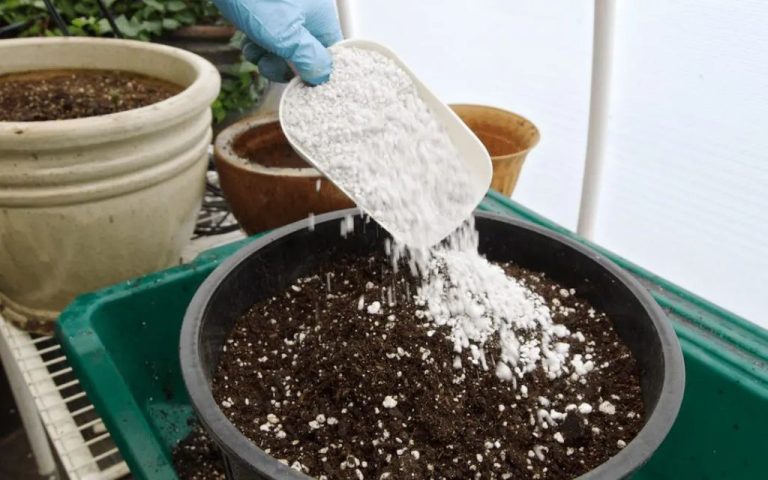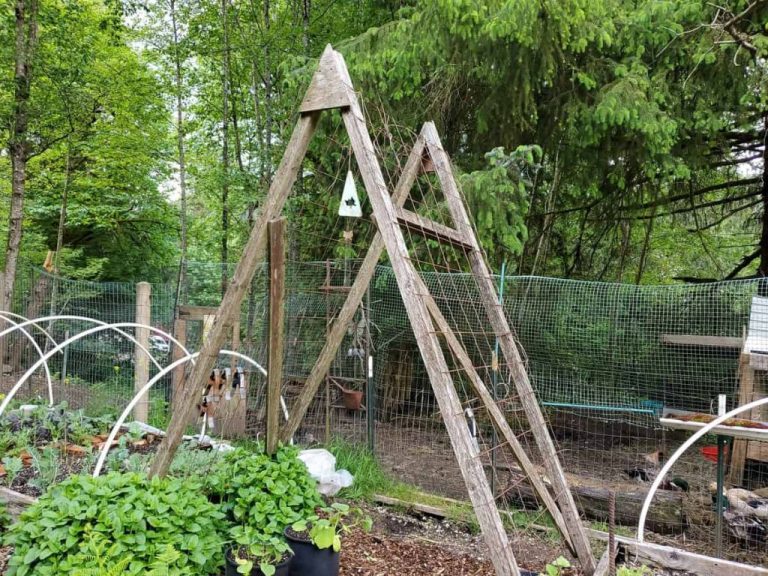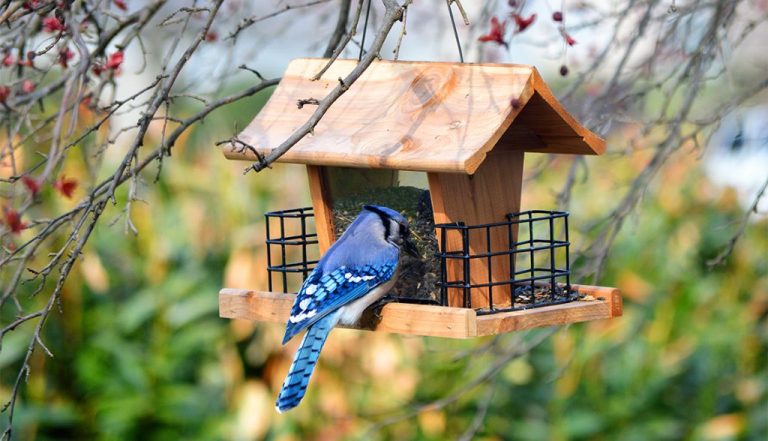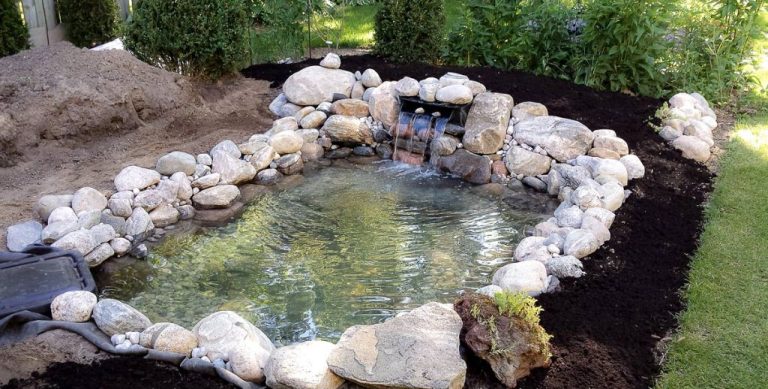Diy Bird Bath: Inviting Feathered Friends To Your Garden
Setting up a bird bath in your backyard is an enjoyable project that provides benefits for both you and local birds. Bird baths give birds a place to drink, bathe, and play (The Benefits of Bird Baths). Having a backyard bird bath attracts a wider variety of birds to your yard as they seek out a water source (7 Benefits of a Bird Bath: Enhancing Your Backyard…).
Watching colorful birds splash and flutter around a bath is relaxing for people and great for bird observation. The sound of chirping and the sight of birds gathering provides an opportunity to enjoy nature up close right in your own yard. Birds also help control insect populations and can pollinate plants (Bird Baths are Back | DIY | Garden Hacks). By setting up a birdbath, you create an oasis for local wildlife while beautifying your outdoor space.
Choosing a Location
Choosing the right location for your bird bath is critical to attracting feathered visitors. According to TikTok, the two main factors to consider are sun exposure and proximity to vegetation.
Birds prefer bathing in sunny spots, as the warmth helps keep their feathers dry quickly. Place the birdbath in an open area that gets at least 6 hours of direct sunlight per day. Avoid shady areas, especially under trees, where moisture can linger.
Elevating the birdbath above ground level provides birds a safer vantage point to watch for predators. Position it on a pedestal or mount it on a fence or post 1-3 feet off the ground. Keep it within 3-10 feet of trees, shrubs or other hiding spots so birds can quickly take cover after bathing.
Be sure to situate the bath at least 10 feet away from areas where cats prowl. Finally, keep it visible from indoor spots you frequent so you can enjoy watching your feathered guests up close!
Selecting a Bird Bath
There are several types of bird baths to choose from for your garden, with different designs and made from various materials. Some key options include:
-
Bowl on a pedestal – This classic style consists of a bowl or basin mounted on top of a standing pedestal, often made of concrete, metal or plastic. They’re easy to install in most gardens and raise the water to a height that attracts birds.
-
Ground-level – These sit directly on the ground, with the water at ground level to entice ground feeding birds. Made of materials like concrete or plastic, they’re ideal for placing in open areas of the garden.
-
Deck-mounted – Installed onto balcony or patio railings, these have bowls that attach to deck rails to hang over the edge. Great for smaller outdoor spaces.
-
Wall-mounted – As the name suggests, these bird baths attach to walls in the garden. The bowl sticks out to hold water for birds.
-
Natural stone – For a decorative look, consider a natural stone bath made of materials like granite, sandstone or limestone. These are heavier and more expensive.
Look for durable materials like concrete, metal or hardy plastics that can withstand the elements. Be sure to choose a size suitable for your space and desired bird visitors.
(Birdspot.co.uk. (n.d.). Choosing A Bird Bath. https://www.birdspot.co.uk/bird-baths/choosing-a-bird-bath)
Adding Water Features
Adding movement and sound to your birdbath can help attract more birds. Features like fountains, misters, drippers, and wigglers create an appealing environment for birds to drink, splash, and bathe. According to The Birdhouse Chick, birds are naturally drawn to moving water sources.
Fountains and bubblers oxygenate the water and prevent it from becoming stagnant. They also provide soothing sounds that birds find inviting. Attach a small pump to create a re-circulating fountain in any birdbath basin. Products like the Bird Bathing Waterfall Fountain (https://www.thebirdhousechick.com/collections/all-bird-baths-accessories?page=5) add a gentle stream of running water.
Misting attachments create droplets that entice birds to fly through and cool down. The Leaf Mister clips onto the birdbath rim and mists water when birds land on it. For a hands-free option, install a Mister Pro which emits a fine spray when motion-activated.
Simple drippers like the Water Wiggler slowly release water droplets into the basin. The moving beads attract attention and their soft sounds are soothing. Wigglers provide interactive play for clever birds who enjoy bobbing on the surface.
Consult reviews like those on We Know Birds (https://www.weknowbirds.com/best-moving-water-bird-baths.html) to pick the right mechanisms for your needs and budget. With so many fountains and accessories available, you can create an oasis for backyard birds.
Planting Around the Bird Bath
The plants around your bird bath can help attract more birds to visit. Choose a variety of plants with different heights, textures, and colors. Here are some great options:
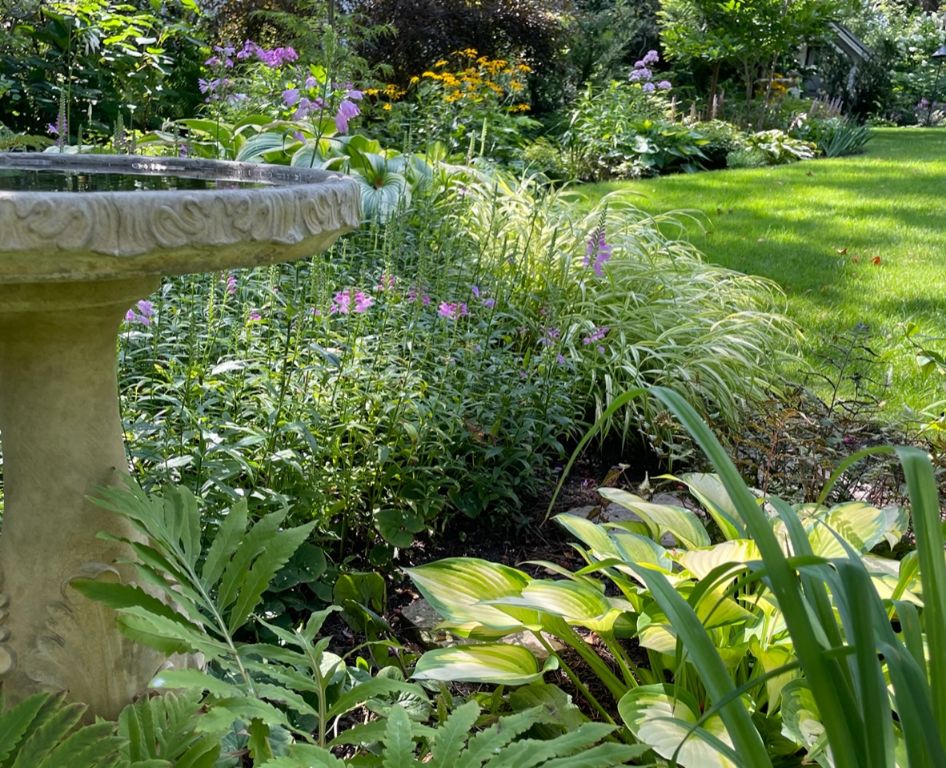
Tall plants like ornamental grasses or small trees provide shelter and places for birds to perch before visiting the bath. Try planting clumping bamboo, ferns, or a crape myrtle tree.
Shrubs like lilacs, hydrangeas, and flowering currant offer food sources as well as cover. Fruiting plants are excellent choices – try blueberry bushes, raspberry canes, grapes, or strawberries.
Herbaceous perennials provide food in their seeds and fruit. Some examples are coneflowers, lavender, and sunflowers. Choose a mix of plants that will provide season-long color and blooms.
It’s best to plant a variety of heights in a semi-circle around the bird bath to create an inviting space. Group 3-5 plants of each type together for impact.
Aim for dense plantings about 3-5 feet away from the bird bath so birds feel protected but still have a clear flight path to the water. Provide both flowering plants for nectar and fruiting plants for food to create a balanced bird habitat.
Keeping the Water Clean
Birds will avoid drinking from dirty water, so it’s important to keep your birdbath filled with clean water. The water should be changed and the basin scrubbed about once a week. Use a scrub brush and a solution of 9 parts water to 1 part vinegar to remove any algae or mineral deposits 1. Avoid using soaps, bleach or other chemicals that could be harmful to birds.
To prevent algae growth, move the birdbath to a shady spot or only fill it partially with water. Algae needs sun and moisture to thrive. Keeping the water moving with a fountain or bubbler can also deter algae. Products containing enzymes or beneficial bacteria can help keep birdbath water clean and prevent buildup 2. Introducing a few copper pennies to the basin water can also help inhibit algae growth.
In winter, freeze-proof heated birdbaths are ideal since they keep the water liquid. For non-heated baths, change the water twice daily in cold weather to ensure it stays ice-free for visiting birds.
Heating Options
Bird baths can easily freeze over in winter, leaving birds without a vital water source. Thankfully, there are options for heating your birdbath to keep it ice-free even when temperatures dip below freezing.
For an eco-friendly solar-powered heating option, consider a solar bird bath heater. These attach to the birdbath basin and harness power from the sun to gently warm the water (Feemiyo Bird Bath Heater). Solar heaters only run during daylight hours, but provide just enough warmth to prevent freezing at night and in early morning.
Another route is choosing an electric or solar-powered de-icer. Similar to pond de-icers, these lower into the bath and keep a circle of water ice-free even in frigid conditions. Select a thermostatically controlled model for efficiency and safety. De-icers allow year-round access to liquid water for thirsty birds.
With a heated bird bath, you can provide birds a reliable water source through harsh winters. Birds need water for both drinking and bathing, so keeping your birdbath thawed is a great way to assist local wildlife when it’s needed most.
Deterring Pests
Bird baths can attract unwanted insects like bees, wasps, and mosquitoes. Here are some tips to discourage them:
Mosquitoes breed in standing water. Change the birdbath water every 2-3 days to disrupt mosquito breeding cycles [1]. Also try using a birdbath agitator or fountain to keep water moving.
Add mosquito dunks containing BTI to safely kill mosquito larvae without harming birds [2]. Change dunks every 30 days.
Plant marigolds around the birdbath, as they deter mosquitoes [3]. Citronella and lavender oil also repel mosquitoes.
Bees and wasps are attracted to birdbaths to get water. Place a shallow dish of water filled with stones nearby for them to use instead.
Safety Tips
Bird baths can pose some safety hazards if not placed and maintained properly. Here are some tips to keep your feathered friends safe:
Avoid drowning hazards by keeping the water level low enough for birds to stand in comfortably. No more than 1-2 inches of water is ideal. Slope the bottom of the bath so it gradually gets deeper in the center.
Position the bird bath away from windows and reflective surfaces to prevent bird strikes. Birds may not see glass and fly directly into windows. Place the bath in an open area of the yard.
Rinse and refresh the bird bath water daily to prevent disease or parasites. Stagnant water allows mosquitoes to breed. Frequent changing keeps the bath clean.
In winter, check that the bird bath hasn’t frozen over. Ice can trap and freeze birds’ feet. Add a bird bath heater or bring the bath indoors if it freezes.
Ensure electric bath heaters are properly installed and grounded. Keep all electrical cords out of the water.
Avoid using treated water or cleaning products in the bird bath, as these can be toxic to birds. Use a mild bleach solution for periodic deep cleaning.
Discourage cats from stalking the bird bath area with deterrents like pinecones or chicken wire. Keep baths away from bushes where cats may hide.
Enjoying Your Bird Bath
With a little TLC and strategic placement, your DIY bird bath will quickly become a birder’s delight. It’s relaxing to observe songbirds splashing playfully in the water on a summer day. You’ll be able to identify frequent visitors as species like robins, finches, sparrows, chickadees and more stop by to bathe and sip water. Bird watching from your porch or window is an easy way to get your daily dose of nature. Keep a pair of binoculars and bird guide handy to aid with identifying different species that visit.
The pleasant sights and sounds of the bird bath will make your garden even more of a sanctuary. You’ll find joy in maintaining the bird bath and landscaping around it as you attract wildlife to your yard. Be sure to keep your bird bath filled with fresh water daily, and empty, clean and refresh it weekly. Providing food and water for birds supports backyard biodiversity as you create an oasis for feathered friends.

